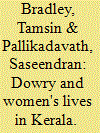| Srl | Item |
| 1 |
ID:
194856


|
|
|
|
|
| Summary/Abstract |
Violence against Women and Girls (VAWG) is endemic in South Sudan. Approaches to end VAWG are barely making a dent in prevalence figures. Global evidence tells us that ending VAWG in conflict-ridden contexts is challenging on many levels. Our research points to the need for social and gender norm change approaches to be better contextualised within the political economy and through applying a nuanced critique of the role of culture in normalising many forms of VAWG. In addition, greater involvement of young people is critical as a behavioural tipping point is beginning to emerge in this group. At national level, a lack of political commitment emerges as a key challenge in ending VAWG. Drawing on the findings from 20 qualitative interviews with national civil society organisation (CSO) and non-governmental organisation’s (NGO) stakeholders, the article argues that current approaches to ending VAWG in South Sudan (and arguably elsewhere) must be reframed along a continuum of change. Activities must be supported at all levels from national through to the grassroots and be founded in a complex picture of the values and beliefs that sustain VAWG.
|
|
|
|
|
|
|
|
|
|
|
|
|
|
|
|
| 2 |
ID:
127082


|
|
|
|
|
| Publication |
2013.
|
| Summary/Abstract |
This article presents new knowledge on the link between dowry and instances of abuse against newly married women. It draws on data collected during structured and in-depth interviews and focus groups involving 60 women in Kerala. The data argue that despite decades of campaigning by women's groups' dowry is still widely practised. Furthermore, the links between dowry, harassment and violence remain. The qualitative analysis of the data reveals how most people hold complex and seemingly contradictory views on dowry. Placing these views along a continuum with 'dowry is a problem' and 'dowry is necessary' at each end enables a picture to emerge of why dowry remains hard to eradicate. Most informants were clear that dowry represents a key problem for women; they also said they would continue to give dowry because it was the only way to secure a 'good' marriage. The data did reveal cracks in the patriarchal system; young women were direct identifying dowry as the main problem they faced. Also, indifferent views were voiced by younger men suggesting they may not forcefully act to maintain the system. Opportunities do exist to push wider holes in the system which could in turn spark the transformation still needed.
|
|
|
|
|
|
|
|
|
|
|
|
|
|
|
|
| 3 |
ID:
189942


|
|
|
|
|
| Summary/Abstract |
In April 2015, a 7.8 magnitude earthquake hit the Gorkha district of Nepal. This was followed in May by a second earthquake. Nepal experienced another natural disaster in 2017. Floods affected large swathes of the country from east to west. Using both qualitative and quantitative data, this article examines the impact of these climate disasters on violence against women. In doing so, it adds to a small but growing and fundamentally important body of literature that explores the intersections of gendered violence and natural disaster. It is well-established that 35% of women worldwide have experienced physical and/or sexual violence. What we know much less about is how other events impact on these figures. Given the growing intensity of climate change and the reality that adverse impacts are here to stay, understanding the detrimental legacy of natural disasters is now more urgent than ever.
|
|
|
|
|
|
|
|
|
|
|
|
|
|
|
|